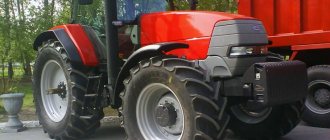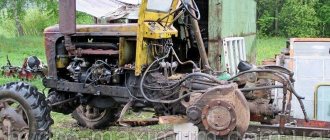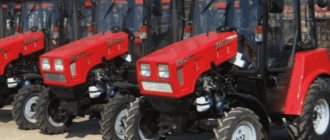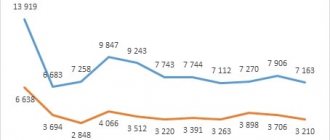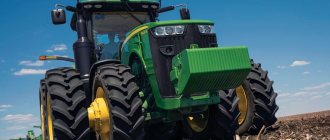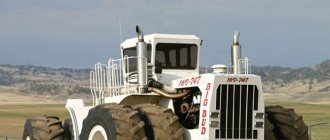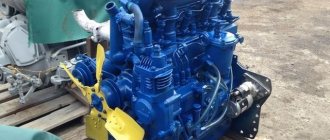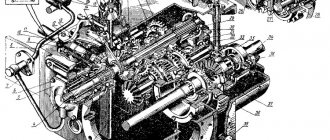Engine 1
converts the chemical energy of fuel and atmospheric air into rotational motion and transfers it to consumers - drive wheels and PTO.
Transmission
transforms the rotational movement, distributes it and transfers it to the drive wheels (track sprockets). The transmission consists of a clutch 9, a connecting shaft 8, a gearbox 7, turning mechanisms 5, a main gear 12 and final gears 6.
Chassis
combines all assembly units into one and serves to move the tractor along the supporting surface. The chassis consists of a frame (frame), suspension and propulsion unit, which includes drive wheels 4 (sprockets), guide wheels 11, support rollers and track chains 10. The propulsion unit interacts with the supporting surface (soil) and converts the rotational motion supplied by the transmission into forward movement of the tractor.
Control mechanisms
, acting on the chassis, change the trajectory of the tractor, stop and hold it motionless.
Working equipment
The tractor consists of a hydraulically driven hitch mechanism 2, a tow hitch 3, a PTO and a drive pulley. The mounted system is designed to attach mounted machines to a tractor and control their operation. Various trailed machines and vehicles are towed using a tow hitch. The PTO is used to drive the working parts of aggregated machines.
Tractor auxiliary equipment
- this is a cabin with a sprung seat, a hood, lighting and alarm devices, heating and ventilation systems, a compressor, etc.
Wheel tractor
The purpose of the components of a wheeled tractor is the same as that of a caterpillar tractor.
Drawing. Layout of the main parts, mechanisms and parts of a wheeled tractor: 1 - steered wheel; 2 — front axle; 3 - engine; 4 — linkage mechanism; 5 - drive wheel; 6 — final drive; 7 — differential; 8 — main gear; 9 — gearbox; 10 - clutch.
Chassis and control mechanisms of a wheeled tractor
consist of a frame, 2 front axle, 5 driving and 1 steered wheels, steering. Between the main 8th and final 6th gears a differential 7 is installed.
Automobile
Main parts of the car
- engine, chassis and body. The schematic diagram of the arrangement of the main parts and mechanisms of a car differs little from their arrangement of a wheeled tractor.
Drawing. Location of the main mechanisms of the car: 1 - steering wheel; 2 — front suspension; 3 — clutch: 4 — gearbox; 5 — cardan transmission; 6 — main gear; 7 — differential; 8 — rear suspension; 9 — drive wheel; 10 - frame; 11 — steering; 12 - engine
Automotive accessories
— this is a towing device, a winch, heating and ventilation systems, a compressor, etc.
The car chassis consists of a transmission, chassis and control mechanisms. A body is installed on the chassis to accommodate passengers or cargo.
The layout of front-wheel drive passenger cars differs from the classic one in that the engine is located across the body and the front wheels are driven. This allows you to reduce the weight of the vehicle, use its space more efficiently, and increase stability and cross-country ability.
Drawing. Transmission diagram of a front-wheel drive car: I - engine; II - clutch; III - gearbox; IV - main gear and differential; V - right and left drive shafts with constant velocity joints; VI - driving (front) wheels.
Wheeled tractors of the Belarusian Tractor Plant of the MTZ series (MTZ-80, MTZ-80L, MTZ-82, MTZ-82L) are universal agricultural tractors of the 1.4 t class. The frame of the tractor consists of a semi-frame (two channels connected by a cast front beam), housings clutch, gearbox, rear axle. The D-240 engine is located in the front part of the structure
(with an electric starter) or D-240L (with a starting engine) with a power of 75-80 hp. c, the rear part of which is rigidly fastened through a sheet to the clutch housing; At the front, the engine is secured using a hinged support. On the front beam there are also water and oil radiators, a shutter for regulating the engine temperature and a power steering. Further, power transmission mechanisms are located directly behind the engine: clutch with brake; reduction gearbox and gearbox, providing 18 forward and 4 reverse gears (a speed reducer can be installed as additional equipment on the left wall of the gearbox housing, which, in combination with the reduction gearbox and gearbox, provides another 4 forward and 4 reverse gears, for a total of 22 forward and 8 back); rear axle with an automatic differential locking system, providing 3 locking zones when the tractor moves in a straight line, as well as forced disabling of the lock; rear power take-off shaft with two-speed independent (548 and 1013 rpm) and synchronous (3.5 rpm travel) drives; side power take-off shaft (727 rpm - without reduction gear and 535 rpm - with reduction gear); The drive pulley (900 rpm - 14.1 m/sec with PTO I and 1678 rpm - 26.4 m/sec with PTO II) can be installed as additional equipment on the rear PTO cover with drive from it.
The running system of the MTZ-80 and MTZ-80 L tractors is the rear driving wheels, the front guides. The wheels are equipped with low-pressure pneumatic tires, the tire sizes of the front wheels are 7.50-20, the rear wheels are 13.6/12-38 (it is possible to install tires 9.5/9-42 and 18.4/15-30). The front guide wheels are mounted on the rotating axles of the front axle, which is pivotally mounted in the bosses of the front beam of the semi-frame. The weight of the tractor is transmitted to the front part of the wheels through coil springs located inside the brackets of the axle retractable knuckles and provide suspension to the front part of the tractor body. The tractor track can be adjusted in the range from 1200 to 1800 mm; the rear wheel track is moved apart by force, using engine power. The front and rear wheels are equipped with protective fenders; the front wheel fenders are attached to the rotary axles, the rear wheel fenders are removable and mounted to the cab. To increase the tractor's traction with the soil, rear wheel weights can be used. You can make the tractor easier to control when working with heavy mounted implements by placing weights on the front wheels on the front beam. To organize in this way a kind of counterbalance.
The hydraulic system of MTZ tractors - a separate unit with a hydraulic grip weight increaser and a power (position) regulator - guarantees the operation of the tractor with agricultural implements and devices, both with and without support wheels. The hydraulic system pump operates from the engine through the PTO drive gears. On the clutch housing there is a housing of hydraulic units - an oil tank on which the hydraulic system distributor, hydraulic adhesion weight increaser and the latter control mechanism are mounted. The hydraulic booster accumulator is mounted to the left sleeve of the rear wheel axle shaft. The leads from the hydraulic system distributor are attached to remote cylinders located in the middle part of the tractor and behind it. The main cylinder and the power (position) regulator (installed at the customer’s request) are located on the rear axle cover under the floor of the tractor cab. On the rear wall of the rear axle housing there is a mechanism for attaching auxiliary implements, which is a four-link hinge with length-adjustable braces. For operation together with trailed machines, a crossbar with a trailing fork is mounted on the longitudinal rods of the linkage mechanism. When operating MTZ tractors, a towing device with a shock absorber and a hydraulic hook controlled by a hydraulic system can be installed (as additional equipment). The tractor is also equipped as additional equipment with remote cylinders with a retarding valve and a fitting assembly, breakaway couplings with a bracket assembly and coupling hoses, a pre-heater, a hydraulic jack, a pneumatic drive system for trailer brakes, a driveshaft guard (for MTZ-82 and MTZ- 82L), as well as a power (position) regulator.
The electrical equipment of the MTZ-80, MTZ-82 tractor with a rated voltage of 12 DC V is a single-wire system (the negative pole of the current sources is connected to ground), including an alternating current generator with a built-in rectifier, batteries, a relay regulator, an electric torch heater (only on MTZ-80), starter, road lights, direction indicators, brake lights, side lights, electric windshield wiper, cabin air heating and cooling unit, horn, courtesy light, seven-pin socket and socket with portable lamp, instrumentation and switching equipment.
The cabin of the MTZ-80 or MTZ-82 tractor is sealed around the entire perimeter, with a rigid frame. It is attached to the tractor chassis at four points on rubber shock absorbers. The cabin is equipped with a heating and ventilation unit, a torsion bar single seat with a hydraulic shock absorber (the seat is adjustable for both height and weight of the person). A first aid kit and a water container should be present in its regular place. The cabin also has a sun visor, a lampshade, and clothes hangers. Windshield wipers and rear-view mirrors are located on the outside of the cab. If necessary, natural ventilation of the cabin is provided through a hatch located on the roof and an opening rear window. The doors can be locked in the open position when a person enters the cabin using a special device. It is strictly forbidden to operate the tractor with the doors open. For ease of entry and exit from the cabin, there is a two-stage step with handrails. The steering wheel can be tilted back. (Special thanks to the designers.) In addition, the position of the steering wheel is adjustable vertically within 120 mm. Two fuel tanks with a total capacity of 130 liters and batteries are located outside the cabin. The tractor hood is attached using two levers to the brackets of the radiator lining and, when opened, bends around the lining, being secured in the open position with a safe latch.
| Due to the large volume, this material is placed on several pages: 2 |
Main portals (built by editors)
reference Information
Documents • Laws • Notices • Document approvals • Contracts • Requests for proposals • Technical specifications • Development plans • Document management • Analytics • Events • Competitions • Results • City administrations • Orders • Contracts • Work execution • Protocols for consideration of applications • Auctions • Projects • Protocols • Budgetary organizations Municipalities • Districts • Education • Programs Reports
: • by references • Documentary base • Securities
Regulations
: • Financial documents
Resolutions
: • Categories by topic • Finance • cities of the Russian Federation • regions • by exact dates Regulations
Terms
: • Scientific terminology • Financial • Economic
Time
: • Dates • 2015 • 2016 Documents in the financial sector • in the investment sector • Financial documents - programs
Brake installation
Homemade mini-tractors can be equipped with both drum and disc brakes. The choice depends on the design of the vehicle’s drive axle, which in a shortened version is installed on a homemade vehicle along with the brakes.
The drive mechanism for drum brake shoes can be either mechanical or hydraulic. For light and medium-sized homemade products, a mechanical drive is sufficient. Disc brakes use a hydraulic pad drive.
To visualize how to create a mini-tractor with your own hands, you can use the video.
Thus, using common components, mechanisms and materials, you can relatively cheaply make your own reliable assistant that will make your work easier when solving various problems.
Education and science
Science
: Tests • Scientific and technological progress • Pedagogy • Work programs • Faculties • Methodological recommendations • School • Vocational education • Student motivation
Subjects
: Biology • Geography • Geology • History • Literature • Literary genres • Literary characters • Mathematics • Medicine • Music • Law • Housing Law • Land Law • Criminal Law • Codes • Psychology (Logic) • Russian Language • Sociology • Physics • Philology • Philosophy • Chemistry • Jurisprudence
Business and finance
Business
: • Banks • Wealth and prosperity • Corruption • (Crime) • Marketing • Management • Investments • Securities: • Management • Open Joint Stock Companies • Projects • Documents • Securities - control • Securities - valuations • Bonds • Debts • Currency • Real estate • (Rent) • Professions • Work • Trade • Services • Finance • Insurance • Budget • Financial services • Loans • Companies • State enterprises • Economics • Macroeconomics • Microeconomics • Taxes • Audit Industry
:
• Metallurgy • Oil • Agriculture • Energy
Construction
• Architecture • Interior • Floors and ceilings • Construction process • Building materials • Thermal insulation • Exterior • Organization and production management
Photo blogs
Art
• Children's creativity • Paintings • Art • Congratulations • Film review • Musical world • Russian rock
World
• People of the world • The world around us • My homeland is the USSR • Nature Channel • Stones and minerals • Cooking, food • Construction and architecture • Under construction • Transport • Weapons • Military transport
beauty
• Fashion Pandia.ru • Girls and Girls
School
• Tests for the Unified State Exam • Solver books • Unified State Examination • 10th and 11th grades • Various textbooks • 4th grade • Russian language grades 5-9 • 5th grade • 6th grade • 7th grade • 8th grade
Wisdom
• Cliparts • Quotes
Author Directory (private accounts)
AutoAuto service • Auto parts • Products for auto • Auto repair centers • Auto accessories • auto parts for foreign cars • Body repair • Auto repair and maintenance • Car chassis repair • Auto chemicals • oils • technical centers • Gasoline engine repair • auto electrical repair • Automatic transmission repair • Tire fitting BusinessAutomation of business processes • Online stores • Construction • Telephone communications • Wholesale companies LeisureLeisure • Entertainment • Creativity • Catering • Restaurants • Bars • Cafes • Coffee shops • Night clubs • Literature TechnologiesAutomation of production processes • Internet • Internet providers • Communications • Information technologies • IT companies • WEB studios • Website promotion • Software sales • Switching equipment • IP telephony | InfrastructureCity • Authority • District administrations • Courts • Utilities • Teen clubs • Public organizations • City information sites The sciencePedagogy • Education • Schools • Training • Teachers GoodsTrading companies • Trade and service companies • Mobile phones • Accessories for mobile phones • Navigation equipment |
Tractor layout
Tractor layout is the relative placement of the main units and working equipment of the tractor, corresponding to its functional purpose and allowing the tractor to be used with the greatest efficiency. The layout is subordinated to the functional purpose of the tractor and is characterized by the size and type of propulsion units, the location of units and systems, the availability of free space for mounting machines, implements and installing technological tanks, the base, the amount of road and agricultural clearance, and the coordinates of the center of mass.
The layout of agricultural tractors is divided into traditional and non-traditional.
Wheeled tractors. Universal row-crop and universal wheeled tractors have the most common traditional (classical) layout with a front-mounted engine, a sequential in-line arrangement of transmission units, a rear-mounted cab, steered front wheels with a diameter significantly smaller than the diameter of the rear wheels (Fig. 2.1,a). The transmission (clutch, gearbox and rear axle) is made in one unit and is rigidly connected to the engine. With this arrangement, up to 70...75% of the tractor's weight in a static position falls on the rear drive wheels, which provide the traction force of the tractor, the front drive wheels (if their drive is provided for by the design) play an auxiliary role when working on wet, loose soil. The classic layout has proven its viability due to a number of advantages: - relative simplicity of design; — maximum use of tractor gravity with the rear drive axle; — good visibility of trailed or rear-mounted implements; — good maneuverability, thanks to the ability to turn the smaller front steering wheels at large angles; - high agrotechnical clearance, etc. All tractors in Russia and the CIS countries of classes (),()... 1.4 (T-25A; T-30A80; LTZ-55; YuMZ-6; MTZ-80/82; MTZ) have this layout -100/102). In recent years, the classic layout has undergone modernization. The so-called improved classic layout has appeared (Fig. 2.1,6). The difference between this tractor layout and the classic one is as follows: - the proportion of the tractor weight falling on the front drive axle has been increased from 25...30% to 35...40%;
Rice. 2.1. Types of layouts of wheeled agricultural tractors: a - classic, b - improved classic, c - with an articulated frame, d - self-propelled tractor chassis; d - tractor with free view; e - load-bearing self-propelled chassis; zh and z - integral tractors
— the tire size of the front drive wheels has been increased; — the front portal axle was replaced with a more powerful automobile type; — the angle of rotation of the front steered wheels has been increased to 50...55° to increase maneuverability; — the front hitch is installed. The VT-170 class 3 tractor, developed by NATI together with VgTZ, has this layout. Wheeled general purpose agricultural tractors 4K46 (Fig. 2.1, c) have a front engine, the cabin is located behind the engine (closer to the middle of the wheelbase), front and rear wheels are the same size and load capacity, and a rigid or articulated frame. Behind the cabin there is free space for installing containers or other technological equipment. The front axle accounts for 55...60% of the tractor's weight. Tractors of classes 3 and 5 (T-150K, T-151K, K-701M, K-734. K-744) have this arrangement. Self-propelled chassis, first mountain crab with free view, and integral tractors are distinguished by their unconventional layout.
Self-propelled chassis (Fig. 2.1, d) in terms of layout occupy a special place among universal tractors. The self-propelled tractor chassis is characterized by the fact that the engine, transmission, control station with the cab form a single unit located above the rear axle of the chassis, the front part is a free frame for installing a body or mounting machines and implements. The T-16MG self-propelled chassis, produced by the Kharkov Self-Propelled Tractor Chassis Plant, is characterized by a rear engine location behind the cab, and the chassis manufactured by Fendt (Germany) is characterized by a horizontal engine location in front of the cabin in the interbase space.
Tractors with free visibility (Fig. 2.1,e) were proposed by Fendt in the early 90s as an intermediate layout between a self-propelled chassis and an integral tractor, aimed at increasing the role of the front drive axle in the implementation of traction force, or increasing the mass of implements mounted on the front .
The load-bearing multi-purpose self-propelled chassis (Fig. 2.1, e) is designed for assembly with harvesting machines (silage and beet harvesters, etc.) and general-purpose implements (front- and rear-mounted plows, cultivators), which increases its annual load. The chassis frame can be solid or consist of two semi-frames connected by a vertical kingpin. To improve chassis handling, the front frame can be made slightly shorter than the rear frame. The cabin has the ability to move along the longitudinal axis, which improves visibility and facilitates the mounting of implements and machines from tillage to harvesting. The modular layout of the engine and transmission units provides easy access to them for maintenance and repair.
The integrated layout (Fig. 2.1,g) has appeared on modern models of agricultural tractors. Its main features are: — the presence of three zones of free space (front, middle, rear) for installing tools or technological tanks; — presence of an extensive PTO system; — front or central location of the cabin with all-round visibility; — four driving and steered wheels of the same size; — the presence of an extensive hydraulic system for controlling implements; — reversing the tractor's progress; — high traction and transport qualities; — the required engine power reserve. This arrangement contributes to a closer functional integration of the tractor with machines and implements.
The “symmetrical” integral layout (Fig. 2.1,3) meets the requirements for the possibility of aggregating a tractor with machines and implements to an even greater extent.
Tracked tractors . General-purpose tracked agricultural tractors with a traditional (classical) layout have a front-mounted engine and clutch. The gearbox and rear axle are located at the rear and connected to the engine by a driveshaft (Fig. 2.2, a). The cabin is located at the rear above the drive wheels (sprockets). This arrangement provides, in static conditions, a slight shift of the center of pressure forward relative to the middle of the track support surfaces and is typical for domestic tractors DT-75M, DT-175M and T-4A.
For tracked tractors with a traditional layout, a different relative arrangement of the units is possible, when the engine, clutch and gearbox are located in the front part of the tractor, and torque is transmitted to the rear drive axle through cardan drives (Fig. 2.2.6).
The unconventional layout of a tracked agricultural tractor with a triangular caterpillar outline, which has appeared in recent years, ensures a shift of the center of mass of the tractor forward, a more uniform distribution of pressure along the length of the supporting surface when working with a load on the hook, an increase in the longitudinal stability of the tractor, and, consequently, a reduction in the danger of lifting its front part at high traction forces.
Specialized tractors . The layouts of specialized agricultural tractors are varied, which is explained by the specific conditions of their work and the requirements of tractor work technologies.
The layout of the slope tractor for working across a slope with a steepness of up to 20° is distinguished by automatic stabilization of the tractor frame in a vertical position in one of three ways: by aligning the wheels relative to the slope or by rotating the final drive housings, by leveling the frame in a vertical position, and by stabilizing the sides using an articulated frame. The first method of stabilizing the frame was implemented in the design of the MTZ-82K tractor, the third - in the self-propelled mountain chassis SSh25G. In some countries of Western Europe with developed mountain agriculture (Austria, Switzerland, etc.), chassis tractors have become widespread for harvesting hay and transport work in high mountain conditions. These tractors have a low-center-of-mass design with a wide track and wide-profile, small-diameter tires.
The portal layout of wheeled and tracked tractors is characterized by the fact that their frames form a fairly high portal enveloping one or two rows of plants, on which a control station with or without a cab is installed.
Rice. 2.2. Arrangement of units in a tracked agricultural tractor of a classic layout: 1 - engine; 2 - fan; 3 — exhaust pipe; 4 - radiator; 5 — clutch; 6 — cardan transmission; 7 — gearbox; 8 — rear axle; 9 — hanging system; 10 — air intake; 11- PTO gearbox
The layout of industrial tractors is very diverse and is determined by the purpose and operating conditions of the machine.
General purpose tractors. The traditional layout of a general-purpose industrial crawler tractor is characterized by a front-mounted engine, a middle-mounted cab, and a rear-mounted rear axle unit. All assembly blocks are installed on a frame or semi-frame, to the front of which is attached the hinge axis of a balancing beam or spring, the ends of which rest on the frames of the tracked vehicles. Tractors with this arrangement are equipped with protective frames (devices that protect the tractor driver, respectively, when the tractor overturns and from falling objects) or cabins with protective frames. Domestic industrial tractors T-130M, T-170M, T-10, as well as their foreign analogues, have a similar layout.
The layout of an industrial tractor with a triangular caterpillar outline (Fig. 2.3) was proposed first for heavy tractors, then for industrial tractors of medium power and for general-purpose agricultural ones. The triangular contour of the tracks provides a number of advantages: - the final drives and the turning mechanism are not subject to the vertical shock load caused by the contact of the drive wheel with the soil; — the center of mass is shifted closer to the front of the machine, which makes it easier to deepen the bulldozer blade; — the presence of an increased supporting surface at the rear behind the drive wheel axle prevents the front part of the tractor from lifting under high traction loads.
Rice. 2.3. The layout of tractors with a triangular caterpillar outline: 1 - bulldozer blade; 2 - hydraulic cylinders, 3 - radiators and fan; 4 — turning mechanism and final drives, 5 — central gear, b — gearbox, 7 — driveshaft; 5 — torque converter; 9 - engine
With this arrangement, the block-modular principle of constructing assembly units is used (Fig. 2.4), i.e. All main components (engine, gearbox, turning mechanism, final drives) are made in the form of separate modules that can be easily dismantled and mounted.
Specialized tractors. The layout of a tracked tractor-loader differs from a general-purpose tractor in that it has an enlarged base due to the introduction of an additional support roller, the installation of a rigid or balancing beam instead of a spring, and the tractor frame being made as one piece with the portal of the loading equipment. To create a counterweight to the weight of the loaded bucket in wheeled tractor-loaders (Fig. 2.5), made with an articulated frame, the engine, gearbox and transfer case are installed on the rear half-frame, and the loader portal is installed on the front. The torque converter is attached to the engine or is mounted in a block with the gearbox. The cabin is placed on the front or rear semi-frame. In the first case, bucket control is simplified, and in the second, engine and transmission control is simplified.
A design feature of swamp tractors is the increased dimensions of the propulsion unit due to the widening of the caterpillar and an increase in the longitudinal base, for example, due to the forced lowering of the guide wheel. The layout of an underground tractor (Fig. 2.6) for working in cramped mining conditions is distinguished by: small dimensions in height; engine located outside the wheelbase; articulated frame. For a radio-controlled amphibious tractor operating at a depth of 6... 7 m, the typical feature is the absence of a cabin, sealing of units and components, and the presence of a mast with an air intake system necessary for engine operation.
Rice. 2.6. Layout of a wheeled underground tractor: 1 - engine, 2.6 - cardan drives; 3 - torque converter, 4 - gearbox, 5, 7 - central and final drives
Tracked forestry (skidding) tractors (Fig. 2.7), which are widely used in Russia and the CIS countries, have a number of design features. The front location of the cabin is determined by the requirement of forward visibility, the need to have a platform for installing various technological equipment and placing a movable pack of rods behind the cabin. A suspension system with large-diameter rollers in combination with a lever-balance suspension, increased ground clearance, highly raised front guides and rear drive wheels provides the ability to overcome obstacles when driving off-road in forests. The lower part of the frame is covered with a bottom, preventing the possibility of branches, logging residues and other objects from penetrating the engine and other tractor units. The presence of a technological platform at the back and side of the cabin allows for pulling trees when pruning branches. Shifting the center of mass of the tractor forward allows you to install a jaw loader on the platform behind the cab. Skidders with this arrangement were developed and mastered at Onega Tractor Plant JSC (TDT-55, TDT-55A, TLT-100, TB-1 and its modifications), at Altai Tractor Plant JSC (TT-4, TT -4M). Abroad, skidders with caterpillar propulsion are used extremely rarely and mainly on specialized feller bunchers.
Rice. 2.7. Layouts of caterpillar skidders: a - with a shield; 6 - with jaw loader, 1 - pusher, 2 - cabin, 3 - engine; 4 - Pfbedka, 5 - gearbox; 6 — cardan shaft; 7 — rear axle, 8 — drive wheel, 9 — hydraulic manipulator
The layout of a forestry tractor for rafting operations (Fig. 2.8) is adapted for movement on water using a water-jet propulsion device and on land using a caterpillar propulsion system. The tractor is equipped with a winch 4, a log pusher / or a bulldozer with a hydraulic lifting capacity of up to 1.5 tons. The average ground pressure on conventional tracks is 0.041 MPa, and on widened ones - 0.027 MPa.
Wheeled forestry tractors have received limited distribution in our country. They are created on the basis of 4K46 tractors, which have free space behind the cab.
Rice. 2.8. Layout of a caterpillar tractor for timber rafting: 1 - log pusher; 2 — cabin; 3 — engine, 4 — winch; 5 — gearbox; 6, 9 - cardan shafts, 7 drive axle, 8 - drive wheel; 10 — vshgt water-jet propulsion
The conditions for the use of wheeled forestry machines with various technological equipment are most fully met by the configurations of multi-axle tractors 4K46, 6K6, 8K8 (Fig. 2.9), which have a greater load capacity, higher traction performance and better cross-country ability due to lower pressure on the ground than that of tractors of traditional layouts. rut depths.
Forestry tractors work with forestry plows, cultivators, uprooters, tree-planting machines, cover strippers and cutters, and also as skidders in forest felling. The layout of general-purpose tracked forestry tractors (Fig. 2.10, a) is practically no different from the layout of forestry tractors and allows for various modifications, including for working on soils with low bearing capacity. A forestry tractor for performing forest reclamation work (Fig. 2.10.6) has an increased supporting surface due to the use of widened tracks and a lowered drive wheel //, which acts as an additional road wheel. At the same time, the average ground pressure decreases from 0.053 to 0.026 MPa, which allows the tractor to be used on waterlogged soils, drained swamps and on virgin lands with a snow cover depth of more than 1 m.
Rice. 2.9. Layouts of wheeled forestry tractors with various equipment based on 4K4 and 6K6 tractors: a - basic model 4K46. b, c — skidders 4K46 s; with a batch gripper and with grosgrain equipment, respectively; d — basic model 6K6, d — skidding Graktor 6K6 with hydraulic manipulator and bunk; e - 6K6 feller-skidding machine with I manipulator and bunk; g — 6K6 delimbing and crosscutting machine, h — 6K6 litter truck with hydraulic manipulator

